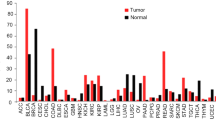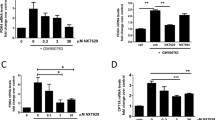Abstract
Peroxisome proliferator-activated receptor-gamma (PPAR-γ) is one of the best characterized nuclear hormone receptors (NHRs) in the superfamily of ligand-activated transcriptional factors. PPAR-γ ligands have recently been demonstrated to affect proliferation, differentiation and apoptosis of different cell types. The present study was undertaken to investigate PPAR-γ ligands induced cell growth inhibition and its influence on matrix metalloproteinase MMP-9 and MMP-2 activities on leukemia K562 and HL-60 cells in vitro. The results revealed that PPAR-γ expression was detectable in the two kinds of leukemia cells; Both 15-deoxy-delta(12,14)-prostaglandin J2(15d-PGJ2) and troglitazone (TGZ) have significant growth inhibition effects on these two kinds of leukemia cells. These two PPAR-γ ligands could inhibit the leukemic cell adhesion to the extracellular matrix (ECM) proteins and the invasion through matrigel matrix. The expressions of MMP-9 and MMP-2 as well as their gelatinolytic activities in both HL-60 and K562 cells were inhibited by 15d-PGJ2 and TGZ significantly. We therefore conclude that PPAR-γ ligands 15d-PGJ2 and TGZ have significant growth inhibition effects on myeloid leukemia cells in vitro, and that PPAR-γ ligands can inhibit K562 and HL-60 cell adhesion to and invasion through ECM as well as downregulate MMP-9 and MMP-2 expressions. The data suggest that PPAR-γ ligands may serve as potential anti-leukemia reagents.










Similar content being viewed by others
Abbreviations
- MMP:
-
Matrix metalloproteinase
- PPAR-γ:
-
Peroxisome proliferator activated receptor-γ
- 15d-PGJ2:
-
15-deoxy-delta(12,14)-prostaglandin J2
- TGZ:
-
Troglitazone
- ECM:
-
Extracellular matrix
References
Theocharis S, Margeli A, Vielh P, Kouraklis G (2004) Peroxisome proliferator-activated receptor-gamma ligands as cell-cycle modulators. Cancer Treat Rev 30:545
Evans RM, Barish GD, Wang YX (2004) PPARs and the complex journey to obesity. Nat Med 10:355
Panigrahy D, Shen LQ, Kieran MW, Kaipainen A (2003) Therapeutic potential of thiazolidinediones as anticancer agents. Expert Opin Investig Drugs 12:1925
Theocharis S, Margeli A, Kouraklis G (2003) Peroxisome proliferator activated receptor-gamma ligands as potent antineoplastic agents. Curr Med Chem Anti-Canc Agents 3:239
Greene ME, Pitts J, McCarville MA, Wang XS, Newport JA, Edelstein C, Lee F, Ghosh S, Chu S (2000) PPARγ: observations in the hematopoietic system. Prostaglandins Other Lipid Mediat 62:45
Asou H, Verbeek W, Williamson E (1999) Growth inhibition of myeloid leukemia cells by troglitazone, a ligand for peroxisome proliferator activated receptor, and retinoids. Int J Oncol 15:1027
Padilla J, Leung E, Phipps RP (2002) Human B lymphocytes and B lymphomas express PPARγ and are killed by PPARγ ligands. Clin Immunol 103:22
Zhang X, Young HA (2002) PPAR and immune system—what do we know? Int Immunopharmacol 2:1029
Berger J, Moller DE (2002) The mechanisms of action of PPARS. Annu Rev Med 53:409
Schiffer CA (2001) Acute myeloid leukemia in adults: where do we go from here? Cancer Chemother Pharmacol 48(Suppl 1):S45
Sievers EL (2000) Targeted therapy of acute myeloid leukemia with monoclonal antibodies and immunoconjugates. Cancer Chemother Pharmacol 46(Suppl):S18
Sternlicht MD, Werb Z (2001) How matrix metalloproteinases regulate cell behavior. Annu Rev Cell Dev Biol 17:463
John A, Tuszynski G (2001) The role of matrix metalloproteinases in tumor angiogenesis and tumor metastasis. Pathol Oncol Res 7:14
Stetler-Stevenson WG (1999) Matrix metalloproteinases in angiogenesis: a moving target for therapeutic intervention. J Clin Invest 103:1237
Kuittinen O, Savolainen ER, Koistinen P, Turpeenniemi-Hujanen T (1999) Gelatinase A and B (MMP-2, MMP-9) in leukaemia MMP-2 may indicate a good prognosis in AML. Anticancer Res 19:4395
Ismair MG, Ries C, Lottspeich F (1998) Autocrine regulation of matrix metalloproteinase-9 gene expression and secretion by tumor necrosis factor-alpha (TNF-alpha) in NB4 leukemic cells: specific involvement of TNF receptor type 1. Leukemia 12:1136
Zhang XM, Huang SP, Xu Q (2004) Quercetin inhibits the invasion of murine melanoma B16-BL6 cells by decreasing pro-MMP-9 via the PKC pathway. Cancer Chemother Pharmacol 53:82
Heath EI, O’Reilly S, Humphrey R, Sundaresan P, Donehower RC, Sartorius S, Kennedy MJ, Armstrong DK, Carducci MA, Sorensen JM, Kumor K, Kennedy S, Grochow LB (2001) Phase I trial of the matrix metalloproteinase inhibitor BAY12-9566 in patients with advanced solid tumors. Cancer Chemother Pharmacol 48:269
Keshamouni VG, Reddy RC, Arenberg DA, Joel B, Thannickal VJ, Kalemkerian GP (2004) Peroxisome proliferator-activated receptor-gamma activation inhibits tumor progression in non-small-cell lung cancer. Oncogene 23:1000
Saez E, Rosenfeld J, Livolsi A, Olson P, Lombardo E, Nelson M (2004) PPAR gamma signaling exacerbates mammary gland tumor development. Genes Dev 18:528–540
Pham H, Banerjee T, Nalbandian GM, Ziboh VA (2003) Activation of peroxisome proliferator-activated receptor (PPAR)-gamma by 15S-hydroxyeicosatrienoic acid parallels growth suppression of androgen-dependent prostatic adenocarcinoma cells. Cancer Lett 189:17
Sato H, Ishihara S, Kawashima K, Moriyama N, Suetsugu H, Kazumori H (2000) Expression of peroxisome proliferator-activated receptor (PPAR)gamma in gastric cancer and inhibitory effects of PPARgamma ligands. Br J Cancer 83:1394
Abe A, Kiriyama Y, Hirano M, Miura T, Kamiya H, Harashima H (2002) Troglitazone suppresses cell growth of KU812 cells independently of PPARgamma. Eur J Pharmacol 436:7
Yamakawa-Karakida N, Sugita K, Inukai T, Goi K, Nakamura M, Uno K (2002) Ligand activation of peroxisome proliferator-activated receptor gamma induces apoptosis of leukemia cells by down-regulating the c-myc gene expression via blockade of the Tcf-4 activity. Cell Death Differ 9:513
Margeli1 A, Kouraklis G, Theocharis S (2003) Peroxisome proliferator activated receptor-c (PPAR-c) ligands and angiogenesis. Angiogenesis 6:165
Ueda Y, Yamagishi T, Samata K, Ikeya H, Hirayama N, Okazaki T, Nishihara S, Arai K, Yamaguchi S, Shibuya M, Nakaike S, Tanaka M (2004) A novel low molecular weight VEGF receptor-binding antagonist, VGA1102, inhibits the function of VEGF and in vivo tumor growth. Cancer Chemother Pharmacol 54:16
Frankel AE, Gill PS (2004) VEGF and myeloid leukemias. Leuk Res 28:675
Konopleva M, Elstner E, McQueen TJ, Tsao T, Sudarikov A, Hu W, Schober WD, Wang RY, Chism D, Kornblau SM, Younes A, Collins SJ, Koeffler HP, Andreeff M (2004) Peroxisome proliferator-activated receptor gamma and retinoid X receptor ligands are potent inducers of differentiation and apoptosis in leukemias. Mol Cancer Ther 3:1249
Azuma Y, Watanabe K, Date M, Daito M, Ohura K (2004) Induction of proliferation by 15-deoxy-delta12,14-prostaglandin J2 and the precursors in monocytic leukemia U937. Pharmacology 71:181
Moehler TM, Ho AD, Goldschmidt H, Barlogie B (2003) Angiogenesis in hematologic malignancies. Crit Rev Oncol Hematol 45:227
Padró T, Berdel WE, Büchner T, Mesters RM (2000) Angiogenesis and anemia in acute myeloid leukemia. Blood 96:3656
de Bont ESJM, Rosati S, Jacobs S, Kamps WA, Vellenga E (2001) Increased bone marrow vascularization in patients with acute myeloid leukaemia: a possible role for vascular endothelial growth factor. Br J Haematol 113:296
Devy L, Hollender P, Munaut C (2002) Matrix and serine protease expression during leukemic cell differentiation induced by aclacinomycin and all-trans-retinoic acid. Biochem Pharmacol 63:179
Zhang B, Wu K-F, Cao Z-Y, Rao Q, Ma X-T, Zheng G-G, Li G (2004) IL-18 increases invasiveness of HL-60 myeloid leukemia cells: up-regulation of matrix metalloproteinases-9 (MMP-9) expression. Leuk Res 28:91
Narla RK, Dong Y, Klis D, Uckun FM (2001) Bis(4,7-dimethyl-1,10-phenanthroline) Sulfatooxovanadium(IV) as a novel antileukemic agent with matrix metalloproteinase inhibitory activity. Clin Cancer Res 7:1094
Hayashibara T, Yamada Y, Onimaru Y, Tsutsumi C, Nakayama S, Mori N (2002) Matrix metalloproteinase-9 and vascular endothelial growth factor: a possible link in adult T-cell leukaemia cell invasion. Br J Haematol 116:94
Lynch CC, McDonnell S (2000) The role of matrilysin (MMP-7) in leukaemia cell invasion. Clin Exp Metastasis 18:401
Acknowledgements
We thank professor Jiang WQ for presenting microculture tetrazolium. We also thank the members of our laboratories for their insight and technical support. This work is supported by the grants from National Natural Science Foundation of China (No. 30471933).
Author information
Authors and Affiliations
Corresponding authors
Rights and permissions
About this article
Cite this article
Liu, J., Lu, H., Huang, R. et al. Peroxisome proliferator activated receptor-γ ligands induced cell growth inhibition and its influence on matrix metalloproteinase activity in human myeloid leukemia cells. Cancer Chemother Pharmacol 56, 400–408 (2005). https://doi.org/10.1007/s00280-005-1029-9
Received:
Accepted:
Published:
Issue Date:
DOI: https://doi.org/10.1007/s00280-005-1029-9




